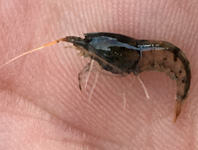Abstract
A new species is described, Hemilamprops chilensis, from Chile. The new species was collected at several localities, from Bahia Herradura in the central part of the country, to Ancud on the island of Chiloe in the south. The depth of collection ranged from 0–30 m. The species with the closest affinity to H. chilensis is the South African species, H. glabrus Day, 1978. The new species is distinguished from all other Hemilamprops by the combination of a short lateral ridge anteriorly on the carapace, maxilliped 3 with the basis much longer than the remainder of the appendage, and the telson bearing 3 terminal setae and 2 pairs of small lateral setae. The identities of H. ultimaespei and H. lotusae are fixed by lectotype and neotype designation, respectively. The lectotype of H. ultimaespei is selected as the neotype of H. lotusae, making H. lotusae a junior objective synonym of H. ultimaespei.
References
Băcescu, M. (1972) Archaeocuma and Schizocuma, new genera of Cumacea from the American tropical waters. Revue Roumaine de Biologie, Academia Republicii Socialiste Romania, 17, 241–250.
Băcescu, M. (1969) Deux Cumaces nouveaux: Diastyloides carpinei n. sp. dans la Mediterranee et Hemilamprops lotusae dans l’Atlantique Argentin. Revue Roumaine de Biologie, Academia Republicii Socialiste Romania, 14, 163–171.
Corbera, J. (2000) Systematics and distribution of cumaceans collected during BENTART-95 cruise around South Shetland Islands (Antarctica). Scientia Marina, 64 (1), 9–28.
https://doi.org/10.3989/scimar.2000.64n19Day, J. (1978) South African Cumacea, Part 3: Families Lampropidae and Ceratocumatidae. Annals of the South African Museum, 76, 137–189.
Gerken, S. (2005) Two new cumaceans (Crustacea: Peracarida) from Cook Inlet, Alaska. Proceedings of the Biological Society of Washington, 118, 674–691.
https://doi.org/10.2988/0006-324X(2005)118[674:TNCCPF]2.0.CO;2Haye, P. & Gerken, S. (2005) A new species of Cumacea (Crustacea: Peracarida) from Chile, Lamprops kensleyi. Proceedings of the Biological Society of Washington, 118 (1), 30–37.
https://doi.org/10.2988/0006-324X(2005)118[30:ANSOCC]2.0.CO;2Mühlenhardt-Siegel, U. (2003) Redescription of Hemilamprops ultimaspei Zimmer, 1921 (Crustacea: Cumacea: Lampropidae) from the Beagle Channel, South America. Mitteilungen aus dem Hamburg Zoologische Museum und Institute, 100, 119–126.
Ledoyer, M. (1993) Cumacea (Crustacea) de la compagne EPOS 3 du R.V. Polarstern en mer de Weddell, Antarctique. Journal of Natural History, 27 (5), 1041–1096.
https://doi.org/10.1080/00222939300770661Sars, G.O. (1863) Beretning om en I sommeren 1862 foretagen zoologisk reise i christianias og throndhjems stifter. Nyt magazine fur naturvidenskaberne, 12, 193–252.
Sars, G.O. (1878) Nye Bidrah til Kundskaben om Middelhavets Invertebratfauna. II. Middelhavets Cumaceer. Archiv for Mathematik ig Naturvidenskab, 3, 461–512.
Sars, G.O. (1900) An account of the Crustacea of Norway. Vol III. Cumacea. Bergen Museum, Bergen, 115 pp.
Teske, P.R., McQuaid, C.D., Froneman, P.W. & Barker, N.P. (2006) Impacts of marine biogeographic boundaries on phylogeographic patterns of three South African estuarine crustaceans. Marine Ecology Progress Series, 314, 283–293.
https://doi.org/10.3354/meps314283Zimmer, C. (1921) Einige neue und weniger bekannte Cumaceen des Schwedischen reichsmuseums. Arkiv För Zoologi, 13, 1–9.

